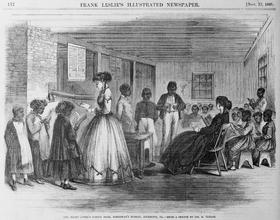Segregation in K-12 Education: Colonial Era
Segregation in K-12 education has been a persistent issue throughout American history, with its roots tracing back to the Colonial Era.
- This essay examines the origins of segregation in K-12 education during that time and explores the differential treatment experienced by Native American, African American, and white students.
- By exploring the historical context and citing relevant sources, we can better understand how educational disparities based on race and ethnicity were established and perpetuated.
Origins of Segregation in K-12 Education
- The establishment of formal education in the American colonies laid the foundation for the early seeds of segregation.
- Native American and African American students were systematically excluded from the educational opportunities provided to white students.
Latin Grammar Schools and Exclusion of Non-White Students
- The Latin Grammar Schools, prevalent in the Colonial Era, primarily served white male students of privileged backgrounds.
- Native American and African American students were systematically excluded from these institutions due to societal norms and discriminatory practices.
Lack of Formal Education for Native American Children
- Native American children faced limited access to formal education during the Colonial Era.
- Instead, they were often educated within their tribes or subjected to assimilationist boarding schools that aimed to eradicate their cultural identities.
Denial of Education for Enslaved African Americans
- Enslaved African Americans were denied access to education through deliberate policies and slave codes.
- Education was seen as a threat to the institution of slavery, with laws prohibiting the education of enslaved individuals.
This video offers an overview of Colonial-era schools.
Differential Treatment of Native American, African American, and White Students
The treatment of Native American, African American, and white students in K-12 education during the Colonial Era differed significantly, perpetuating racial and ethnic disparities.
Limited Educational Opportunities for Native American Students
- Native American students had limited access to formal education provided by the colonies.
- They were often educated within their tribes, learning traditional knowledge and skills, but were denied the educational resources and opportunities available to white students.
Denial of Education and Systemic Inequality for Enslaved African Americans
- Enslaved African American children were systematically denied education to maintain the oppressive system of slavery.
- Slave codes explicitly prohibited their education, perpetuating systemic inequality and denying them personal and intellectual development opportunities.
Privileged Education for White Students
- White students enjoyed privileged access to formal education during the Colonial Era.
- They had the opportunity to attend Latin Grammar Schools and receive a quality education that prepared them for societal leadership roles.
This video offers another look at Colonial-era schools.
Descriptions of the facilities used for those colonial schools
- You and I are familiar with modern public school facilities with grand buildings, athletic facilities, and auditoria.
- But I wondered what school buildings looked like in colonial times. Here is what I discovered.
Dame Schools
- were small, informal schools typically run by a local woman, often referred to as a "dame."
- These schools were usually held in the dame's home or a small building in the community.
- The facilities were modest, consisting of a single room furnished with basic desks or benches, a chalkboard, and possibly a small collection of books.
Latin Grammar Schools
, also known as Latin schools or grammar schools, were more structured educational institutions that primarily catered to boys from affluent families.
- The facilities were relatively better than dame schools, usually housed in larger buildings.
- These buildings featured multiple classrooms, a headmaster's office, and a library. T
- hey were often located in urban centers or larger towns.
- Charity schools were established to provide education to poor or disadvantaged children.
- The facilities for charity schools were often quite humble, with basic structures or rented rooms.
- The classrooms were simple, with plain benches or seats for students.
- Funding for these schools came from charitable donations, and the emphasis was on providing the essentials for education rather than lavish facilities.
Church-Related Schools
- Many colonial schools were affiliated with churches, especially in New England.
- These schools, often called parochial schools, were typically attached to a church building.
- The facilities included classrooms within the church building or adjacent structures, such as a parish hall.
- These schools often had a religious focus, integrating religious instruction into the curriculum.
Academies
- Academies emerged later in the colonial period and were considered more advanced learning institutions.
- These schools provided education beyond essential reading and writing and offered subjects such as mathematics, science, and classical languages.
- The facilities for academies were relatively more sophisticated, with larger buildings that housed multiple classrooms, libraries, laboratories, and dormitory accommodations for boarding students.
- It is important to note that the facilities of colonial schools varied widely based on resources, geography, and the social and economic circumstances of the communities they served.
- These descriptions provide a general overview, but the specific conditions and facilities would have varied significantly from one colonial school to another.
Conclusion
The in K-12 education during the Colonial Era can be traced back to the deliberate exclusion and differential treatment of Native American, African American, and white students.
Native American and African American students faced limited educational opportunities, while white students enjoyed privileged access to quality education.
Understanding this historical context is crucial for comprehending today's deep-rooted educational disparities.
By acknowledging these origins, we can strive for a more equitable and inclusive education system that ensures every student has equal opportunities for learning and growth.
Note: The sources used in this essay include "A History of Education in the United States" by John D. Pulliam and James Van Patten.
Questions? Contact us on Facebook or Instagram. @publicschoolreview
#ColonialEducation #SegregationinSchools #DifferentialTreatment #EducationInequality














